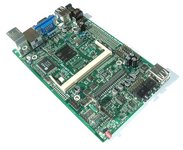Tutorial tackles ARM-based web kiosk
May 1, 2009 — by Eric Brown — from the LinuxDevices Archive — 10 views Part Four of Simtec's series on embedded Linux system development covers the construction of an ARM-based web kiosk system. Written by Vincent Sanders (pictured) and Daniel Silverstone, both from UK-based Simtec Electronics, the tutorial explores power management and other issues involved with… deploying an ARM9-based kiosk.
Part Four of Simtec's series on embedded Linux system development covers the construction of an ARM-based web kiosk system. Written by Vincent Sanders (pictured) and Daniel Silverstone, both from UK-based Simtec Electronics, the tutorial explores power management and other issues involved with… deploying an ARM9-based kiosk.
Part One of the series walked new Linux developers through the construction of a simple embedded Linux system, and Part Two explained how to construct a simple web server with a command shell on the console. Part Three extended the techniques learned about using a command shell on the serial console to the development of a web browser for a kiosk system. Topics included choosing and configuring a web browser (NetSurf) and developing a configuration script.
Up to this point, the authors have used the QEMU emulator to avoid issues surrounding particular hardware and processor platforms. However, each platform raises different issues, especially surrounding power usage, which must be addressed, say the authors. “It is rare for an embedded system to have no limits on its hardware resources,” write Sanders and Silverstone. “In fact, it is common for a project brief to severely limit the available hardware platform, generally through cost and size, but increasingly through power usage.”
 Simtec's BBD20EUROA thin client board (Click for details) |
The tutorial looks at various options that affect power, from attempting to run on batteries or Power-over-Ethernet (PoE), neither of which is feasible for most kiosks, to using traditional CRT monitors, which can be cheaper, but which add considerably to power draw and size. For the LCD-based systems typically used by kiosks, ARM processors are typically used due to their lower power consumption, say the authors.
For their example, the tutorial uses Simtec's BBD20EUROA thin client board (pictured), which is based on its Simtec IM2440D20 module. This module, in turn, incorporates an “oldie, but a goodie,” the ARM9-based Samsung S3C2440 processor.
The tutorial then works through various issues surrounding power usage and unit costs, before picking up where it left off from Part Three and modifying the configuration script for the hardware in question. The authors then show various option used to emulate the target hardware.
Part Four of the Simtec tutorial is available here:
This article was originally published on LinuxDevices.com and has been donated to the open source community by QuinStreet Inc. Please visit LinuxToday.com for up-to-date news and articles about Linux and open source.